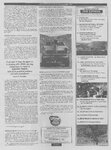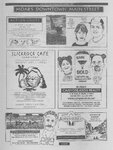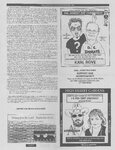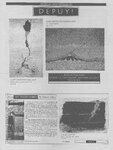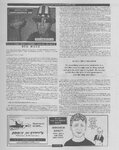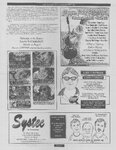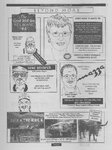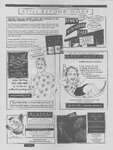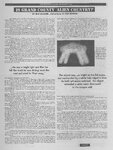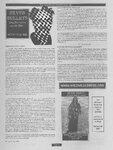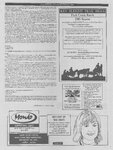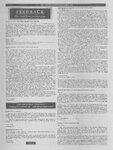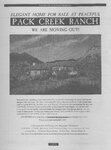| OCR Text |
Show THE ZEPHYR/AUGUST-SEPTEMBER 2005 - LOOKING FORWARD 10 me 'GOOD OLD DAYS: BRACE YOURSELF, MOAB...THE THIRD URANIUM . BOOM If ON THE WAY BY MARK STEEN “Fortunes were made in the first and second uranium booms and fortunes are now being made in this, the third uranium boom,” organizer and host Arden Larsen said to his audience of nearly 300 attendees of the Uranium Expo 2005 in Grand Junction, Colorado on June 18. Larson was referring to the 1950s uranium boom that was fueled by the country’s need for uranium for national defense; and the 1970s uranium boom that fueled the 103 nuclear reactors which now provide nearly 20 percent of the electricity generated in the United States. The next uranium boom is the inevitable consequence of the failure of the power industry and government regulators to realistically address the need for new sources of energy during the last two decades. The revived prospects for nuclear power stem from the volatile energy market and environmental concerns about global warming. Skyrocketing natural gas prices and the costs of containing carbon emissions from coal-fired power plants have forced electric utility companies and some environmentalists to embrace nuclear plants as the only realistic economic and environmental alternative to fossil fuels. New, safer reactor designs and waste storage solutions are being proposed for the next generation of nuclear plants. Construction of new nuclear power plants in the United States has been out of fashion since the 1979 Three Mile Island accident, multi-billion dollar construction cost overruns, and long-term disposal and storage concerns over nuclear waste. During this same time, most of the other developed countries have turned to nuclear reactors in order to meet their growing energy demands. There are currently 441 nuclear power plants in operation in 30 countries, with at least 30 new power plants under construction and an additional 34 plants in the planning stages. : Many individuals actually made real fortunes from uranium. More millionaires were made on the Lisbon Valley Anticline than any other uranium mining area in America. Big deals were almost commonplace in the 1950s. New York financier Floyd Odlum spent $60 million acquiring uranium properties for companies that he eventually merged into Atlas Corporation. That figure includes the $9 million he overpaid Vernon Pick for the mine Odlum called the Hidden Splendor before he realized it wasn’t worth a third of that amount. (Everyone always called it the Hidden Blunder Mine.) The three owners of the Happy Jack Mine in the White Canyon District divided $6 million for their property. Dozens of other mine owners and operators made more money than they ever saw again in the first uranium boom. Thousands of people invested in hundreds of penny uranium stock promotions; and plenty of small fortunes were made by people on both sides of these speculative deals when claims changed hands. Between 1948 and 1971, the AEC purchased nearly 350 million pounds of uranium concentrate at a cost of almost $3 billion from more than 30 uranium mills operated under AEC contracts. The Uranium Reduction Company / Atlas Millin Moab accounted for more In a novel twist that will give new meaning to Jane Fonda’s movie The China Syndrome, that country has announced plans to build 40 new nuclear reactors in the next 15 years. A uranium poor country, China has reportedly been attempting to secure long-term contracts in Australia and Canada. And Russia’s government has stated that it is going to limit their exports to conserve fuel for the 25 nuclear power plants they plan to build by 2020. ; The revived prospects for nuclear power stem from the volatile energy market and environmental concerns about GLOBAL WARMING The uranium that is needed just to fuel the operating nuclear power plants is approximately 175 million pounds a year. World production of uranium is around 94 million pounds. That’s an 81 million pound shortfall. During the last two decades, this production shortfall has been filled by converting around 40 percent of Russia’s nuclear weapons arsenal to nuclear fuel, and by the sale of privatized government stockpiles. Production in the United States has fallen from 44 million pounds in 1980 to 2.2 million pounds, which is far less than the approximately 60 million pounds that this country’s nuclear power plants consume. Current and planned uranium mines cannot possibly supply the projected demand for all of the nuclear plants that will be in operation within the next twenty years. To state that the supply of uranium is inadequate is a massive understatement. Uranium is the most unbalanced commodity in the world. This shortfall has pushed uranium prices from a low of $7 a pound to more than $29 a pound during the last four years. If present price trends continue, uranium will hit $45 a pound within a year and may reach $110 a pound within the next five years. If this seems improbable, consider this: in inflation adjusted terms, $110 is roughly equivalent to the old high of $43 a pound that uranium concentrate (called yellowcake because of its color) sold for in 1979. Given the fact that new nuclear power plants could cost between $1.14 and $1.18 billion, the acquisition costs of the uranium needed to fuel a reactor for its _ lifetime is almost insignificant. Since most of those who felt the full impact of Charlie Steen’s Mi Vida Mine discovery in San Juan County’s Big Indian Mining District are no longer around, it might be instructive to recall the days when Moab was proud to be the “Uranium Capital of the World.” The first uranium boom resulted from the urgent need for a secure domestic source of uranium for the production of atomic weapons during the Cold War arms race with the Soviet Union. Prior to the discovery of the large, high-grade uraninite ore deposits located in the Big Indian Mining District, the United States was forced to buy ninety percent of its radioactive materials from the Belgian Congo and Canada. The country’s need for uranium for national defense was so urgent that the Atomic Energy Commission (the AEC) decided it had to stimulate domestic prospecting and production through an incentive program of guaranteed prices, discovery bonuses, and development loans. Few government sponsored procurement programs in history have ever been as successful as the AEC’s was in the first uranium boom. The first great quest for radioactive minerals forever changed the remote and beautifully desolate Colorado Plateau. Widespread publicity about my father’s prospecting saga and his fabulous discovery caught the attention of the public and he became the embodiment of every adventuresome man’s dream to strike it rich. In the ensuing rush for uranium riches, tens of thousands of amateur prospectors set out with Geiger counters and high hopes of hitting the uranium jackpot. The isolated and conservative Mormon towns of Moab, Monticello, Blanding, Hanksville, and Bluff were overwhelmed by the greatest rush for riches America ever experienced. The wide streets and few cafes and motels in these small towns were choked with a restless, questing humanity in search of the next Mi Vida Mine. And, the Big Indian District’s large uranium ore bodies attracted well- established mining companies that had previously been uninterested in exploring for uranium. Hundreds of geologists, mining engineers, and surveyors found employment and added a professional hand to the rank amateurs. Soon, more uranium ore bodies were discovered in New Mexico, Wyoming, Colorado, and Washington. Charlie & ML Steen with youngest son Mark in the mid-50s Current and planned uranium mines cannot possibly supply the projected demand for all of the projected nuclear power plants that will be in operation within the next 20 years.... Uranium is the most unbalanced commodity in the world than 40 million pounds of yellowcake costing the government $325 million. A similar amount of uranium concentrate purchased at the projected price of $110 a pound would generate $4.4 billion. Compare that figure to the amount of money Moab’s motels and restaurants rake in during the tourist season and it’s easy to see why some old timers are looking forward to the good old days. The second uranium boom lacked the excitement and public mania of the 1950s boom, but fortunes were made and nearly as many millions of pounds of uranium concentrates were sold to public utilities for use in nuclear power plants as previously were used in nuclear weapons. Rio Algom’s Lisbon Valley Mine and Mill were brought into production in 1972 with a contract for sale to a power company. The three owners of the claims that Rio Algom leased made millions from their property. Prices increased from $6 per pound in 1971 to over $43 per pound by 1973. However, few of the nation’s uranium producers were able to take advantage of these high prices because they had locked into long-term contracts at much lower prices. Atlas Minerals was caught in a price vise when its long-term contract with a utility company to provide yellowcake at $11 per pound collided with its diminished ore reserves and increased production costs. Only the relatively late discovery of the high-grade Velvet ore body in lower Lisbon Valley enabled Atlas to fulfill its contract. The Velvet ore deposit was discovered by several uranium savvy locals exploring under a finder’s fee agreement paying $3 for every pound produced. They made millions. That agreement did not leave room for much profit, but it kept the company alive. Atlas managed to stave off its financial collapse by selling some of its production for higher spot uranium prices during its last decade as the mainstay of southeastern Utah's uranium industry. : PAGE8 |


